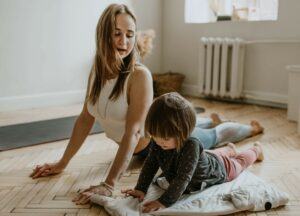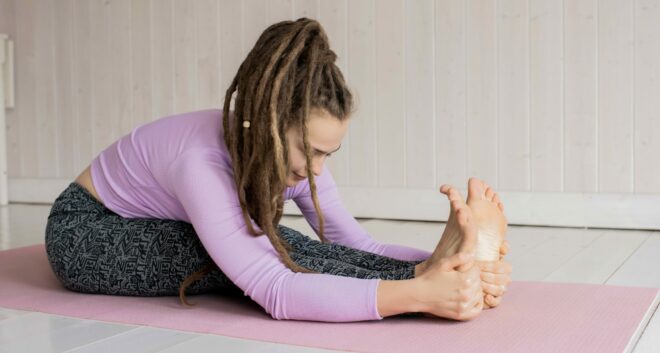As you age your ligaments and tendons tighten. Stretching improves your joints’ ability to carry out daily tasks and physical activities. Studies show that you can maintain your range of motion and flexibility by doing range of motion and flexibility stretches every day. What you really need is stretching exercises for flexibility of movement!
Identifying a Static Stretch
Static stretches involve holding a stretch in a comfortable position for a length of time, typically between 10 – 30 seconds.
Static stretches are considered the safest way to stretch. You are targeting a specific muscle or group of muscles. Do not push or pull your muscles but rather hold them steady. Do not bounce your muscle but rather hold them taut.
Identifying a Dynamic Stretch
Dynamic stretches are active, which prepare your muscles for movement. They are usually done before exercise. They cause your muscles to stretch, but the stretch is not held for any length of time.
When you want to play ball, you may want to practice swinging the bat. This type of movement stretches a group of muscles in an active more natural way. It improves your range of motion and gets your blood pumping. However, as you get older, you must be more careful about doing dynamic stretches to avoid injury.
Stretching Exercises for Flexibility
- Stretching can help reduce back pain. A regular stretching routine can help you strengthen back muscles to prevent future pain and injury.
- Stretching can help improve your posture. By strengthening muscle groups and encouraging proper alignment you may be surprised at how your posture improves.
- Stretching can be beneficial for arthritis. Stretching on a regular basis may increase your range of motion.
General Guidelines
Before beginning this or any exercise program, always check with your
doctor or health practitioner to see if it is right for you.
Stretching should not be painful. If you experience pain, stop at the point before pain begins. Use gentle movements. This will reduce the possibility of injury.
Another major mistake is forgetting to breathe. Your cells need oxygen to perform well. It has been said that the only exercise you should do when holding your breath is underwater swimming.
Protect your back. When doing back stretches, do not combine turning and bending at the same time. Do each type of stretch separately. You can sit on a sturdy chair and place your hands on your legs for support before doing a forward leaning stretch.
Stretching will loosen tight muscles quickly. It will raise your body temperature and make your muscles more elastic.

Start the Day by Stretching
First thing in the morning, when you get out of bed is a great time to stretch. Start from the head and stretch all the way down to your toes.
The Neck
Move the head gently from side to side, never too quickly. First to the right and hold that position for 15 to 20 seconds then to the left and hold that position for 15 to 20 seconds. Do not rotate your head rather go from side to side. Avoid pressing the neck backward to prevent damage to your neck vertebrae.
The Shoulders
Rotate your shoulders forward, and again in a backward direction.
Pull your shoulders down and back. With hands clasped behind your back, pull your hands downward to bring your shoulder blades closer together.
Arm Raises
With palms facing forward and elbows bent, stretch arms overhead as far as possible.
The Arms
One good way to give your arms a good stretch, is one at a time, raise each arm above your head, bend your arm at your elbow. Now with your other arm reach up and gently pull your bent arm and feel a light stretch in the back of your arm. Hold it for 15 to 20 seconds then repeat with the other arm.
The Lower Back
A physiotherapist suggested that I stand at the kitchen sink with my back to the counter and gently arc my back, bending backwards over the sink as I look toward the ceiling. That one I like to do often.
It seems I am often bending over my desk, and with that stretch I get the kinks out as I bend the other direction.
The Quadriceps Stretch
To stretch the quadriceps muscle at the front of your thigh, begin by standing tall with your hand on the counter or the back of a sturdy chair for balance. Bend your right knee behind you and grasp your foot behind you. (If you are flexible enough.) If not, use a resistance band or belt. You will feel the stretch through the front of your thigh. Hold your foot up for 30 seconds then repeat with the other foot.
The Ankles
Strong flexible ankles are necessary to prevent falls and help you maintain your balance. The Arthritis Society recommends that you sit upright, keep abdominal muscles tight, chest high with legs stretched out in front. Slowly circle your feet in one direction 20 times, then in the other direction 20 times.
The Hips
You can stretch your hips by sitting in a sturdy chair and cross one ankle over the other knee. Gently press down on your knee. Hold for 20 seconds then cross the other leg and repeat.
The Cow-Cat Pose
If you are ready to get down on the floor for a few quick workouts, you can do the “cow-cat” pose.
With hands under the shoulders and knees under the hips, arch your back, tucking your head under.
Then reverse the pose by lifting your head and chest toward the ceiling.
Low Back Stretch
Finally lie on your back and pull your right knee towards your chest. Hold for 30 seconds then repeat with the other leg. You should feel a gentle stretch in your lower back, glutes and hamstring.
From Your Head to Your Toes
I like to work my way down from my head to my toes when I do my stretches. It is recommended that you do these stretches every day to stay flexible and remain as active and as independent as possible.
There are other possible exercises to incorporate stretching such as Tai chi, Pilates, Yoga, Walking, and Water exercises.
Stretching exercises for flexibility will only benefit you if performed regularly and in proper form.
Comments Please
I would love to hear from you. What stretching exercises for flexibility do you do?
Disclaimer: If you have any concerns or questions about your health, you should always consult with a physician or other healthcare professional. No content on this site should be substituted for direct medical advice from your doctor or another qualified healthcare practitioner. The information contained here is for informational purposes only. It is from my research and personal experience.


I appreciate you included all these stretching exercises in this post. I will start tomorrow stretching. It has such a calming effect.
I have learnt the importance of stretching the bad way: I got injured. I have been learning to play tennis and decided to skip stretching. Not a good decision. I have a couple of weeks completely restored but now with this COVID-19 I must remain at home. But even though I can’t play… I’ll still stretch.
Hi Ann, and welcome! Thanks for the comment.
Stretching loosens our ligaments and tendons. It makes us more flexible and helps us maintain good posture.
Miranda Esmonde White has quite a few routines that she has put out on DVDs and YouTube which I enjoy. She was a ballet teacher who saw the importance of stretching, and spent a lot of time teaching people how to stretch correctly. I find it quite helpful with lower back pain and posture.
When we can’t get outside, stretching is something that we can all do at home.
Hello Carolyn, exercising is very great for the body and with focus on stretching, I am pleased with how flexible one can be when you do it regularly. I am more of a building muscle kind of person, but lately i am beginning to see the need to be flexible and that’s why I am willing to try stretching out. One part of the body I really need to get flexible enough is the shoulder and I hope it goes well. How soon before it gets flexible?
Hi Benson, and thanks for the comment.
It is beneficial to keep from injuring your body by warming up first. To warm up you could simply go slowly into each exercise. If you are doing body-weight exercises, start slowly until your muscles are warmed up.
Work on stretches after your muscles are warmed up. It is good to stretch after a workout.
To cool down, our muscles need stretching after a long workout when they are relaxed and thoroughly warm. Cooling down stretches, help you maintain or increase your range of movement and increase your flexibility. If you do this after each workout you should find an increase of flexibility.
This is great and surely, I’m getting started right away and I will make sure that this will become my morning routines henceforth. To be honest, this is great and stretching generally has a way of making the whole body calm and collected. I never thought about the different types but I just knew that stretching could be done in so many ways. Thank you for this
Stretching is a great, low-impact way to go to get the blood moving in our bodies. If we have a job that requires us to sit much of the day, it is great for our muscles and ligaments to get a good stretch so we don’t get tight and sore muscles.
Yoga is a great stretching exercise.